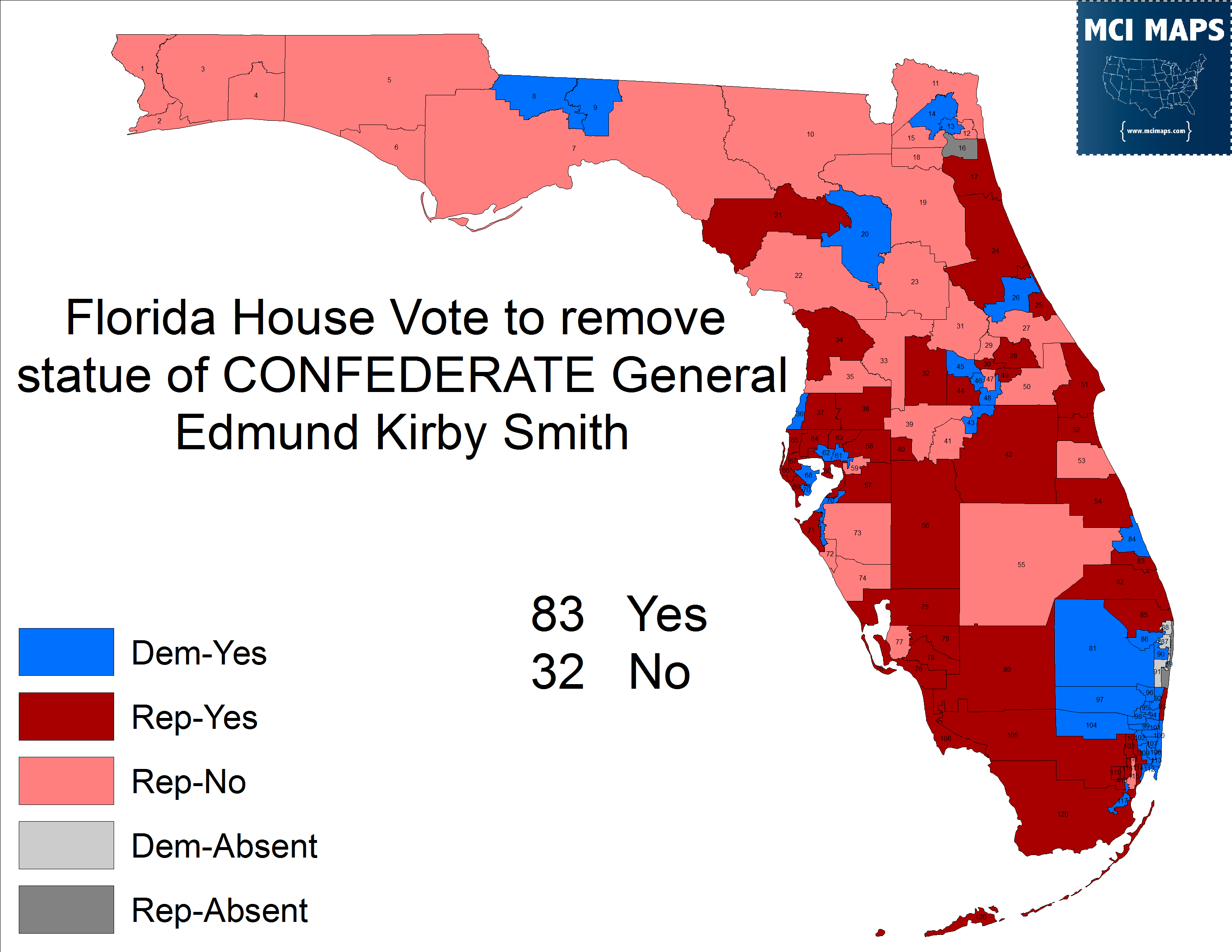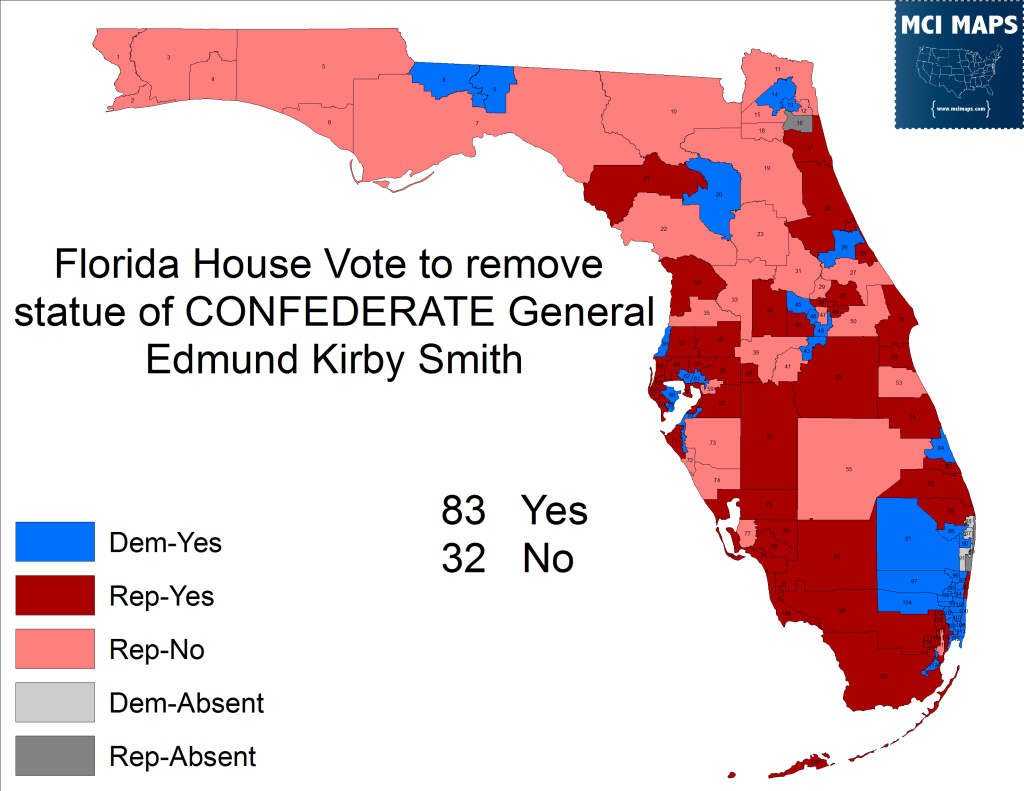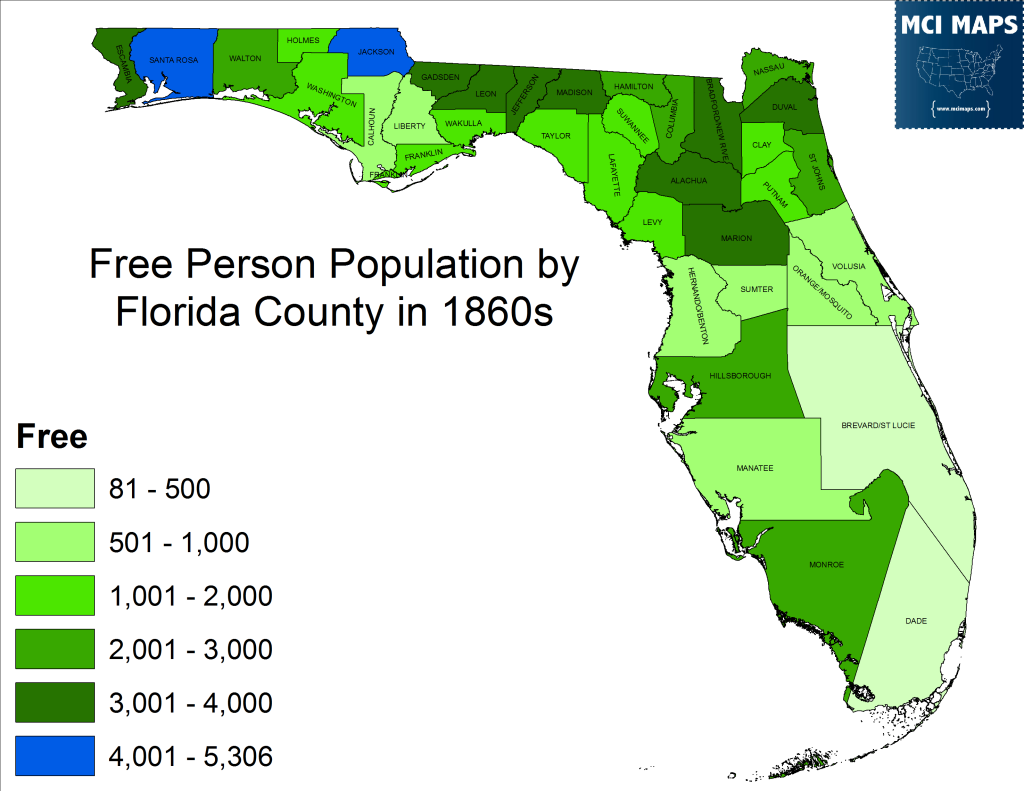On February 23rd, the Florida House voted to remove a statue of Confederate General Edmund Kirby Smith. The vote was pushed by Democrats and African-American lawmakers as part of a growing movement in southern states to remove old symbols of the Confederacy. The Senate passed the removal 33-7 and the House concurred 83-32. The map below shows the House vote. All no votes came from Republicans.
What was especially notable was that so many votes came from outside North Florida, the largely conservative/rural region with strong ancestral ties to the old Florida that seceded in 1861. That would be the region most likely to resist “changing history,” as defenders of these symbols often characterize it.
Florida’s Population During the Civil War
It is important to note that during the time of the Civil War, the overwhelming majority of Florida’s population was above what is now Orlando. The panhandle, from Pensacola to Jacksonville, dominated population and government in the state. The map below shows the population figures of Florida’s 1860 counties according to that year’s census. Most settlements south of Tampa were along the coast, with citizens sparsely populated in the interior of the state.
The other factor in play is the legacy of slavery in Florida. Florida had many large plantations in its northern end where cotton was grown. Several North Florida counties had slave populations outnumbering free people. Slave populations, just like free person populations, dramatically fell off the further south you went. A handful of large plantations dotted the regions of Florida south of Tampa, but a vast majority of slaves and plantations were in the North. The map below shows the % of the population that were slaves, with the number listed being the figure listed during the 1860 census.
Factoring in these population numbers, let’s take a look at the vote count.
The Old Confederacy Districts
Many of the “no” votes came from regions of the state that were well-populated and part of Florida during the Confederacy. While the entire state was, of course, part of the Confederacy, the regions south of Orlando had little involvement with the war and have few residents with descendants who lived there at the time. This area is extremely conservative outside of Tallahassee and the African-American community (which make up the only Democratic seats in the area). Much of the area is very rural, with some suburban pockets.
District 1 — Clay Ingram
District 2 — Mike Hill
District 3 — Doug Broxson
District 4 — Matt Gaetz (The most racist member of the Florida House, also has a DUI arrest on his record.)
District 5 — Brad Drake
District 6 — Jay Trumbull
District 7 — Halsey Beshears
District 10 — Elizabeth Porter
District 11 — Janet Atkins (Openly, and mistakenly, talked about trying to use prisons to gerrymander black lawmakers out of office.)
District 12 — Lake Ray
District 15 — Jay Fant
District 18 — Travis Cummings
District 19 — Charles Van Zant
District 22 — Charlie Stone
District 23 — Dennis Baxley
There were some notable Yes votes from Republicans in this region of the state. Cyndi Stevenson (17th), Fred Costello (25th) and Paul Renner (24th) represent the St. Johns and Flagler regions. The areas had a significant slave population and St. Johns was especially well populated during the Civil War. The region is a mixture of history and suburban growth, meaning these lawmakers had more voters with descendants who came to Florida post-Civil War than before. Keith Perry (21st) stands out as he represents many rural old-Florida regions as well as part of Gainesville. Perry’s vote was very likely tactical, as he just announced he will be running for a swing senate seat in the region.
New Florida Districts
The arguments of the lawmakers in the old Confederacy category for keeping the statue is respecting the history and culture of the state. These lawmakers represent areas with a large number of descendants from Florida in the Civil War era. Further south, the population grows more diverse, with people having descendants that migrated to the state in the 20th century. The lawmakers in this category have no reason (as stupid as the above reason is) to vote to keep the statue. In addition, several of these members’ districts are in areas that had significant slave populations leading up to the war. While some of the lawmakers may claim their vote is about history and not about slavery, those especially with significant slave history in their districts are casting votes for a man who defended that institution that kept people in their region 150 years ago shackled in chains.
District 27 — David Santiago. Santiago sits in a district in South Volusia, a region that had much lower population in 1860 and today is dominated by people who moved into the region after the Civil War.
District 29 — Scott Plakon. Plakon represents part of Seminole County, a region that had less than 500 free people in 1860 and hardly any slaves. Plakon’s vote is way out of step with the suburban moderate Republicans of his district, who would easily prefer moving forward.
District 31 — Jennifer Sullivan. Sullivan represents East Lake and North Orange and this part rural/part suburban district also has little ties to the 1860s population.
District 33 — Marlene O’Toole. O’Toole’s district has some, but still limited ties, to the Civil War era. The district is home to suburbs that have grown in the last several decades and is home to The Villages, the largest retirement community in Florida, largely made up of non-locals. O’Toole cannot claim she is representing the large swaths of voters in her district who simply want their families’ heritage not swept under the rug. In addition, the region of O’Toole’s district had a notable slave population, with then-Sumter county having over 500 slaves on assorted plantations.
District 35 — Blaise Ingoglia. Ingoglia’s vote is especially insulting since he is also the Chairman of the Republican Party of Florida. Ingoglia’s district was sparsely populated in the 1860s and while slavery was not common in the region, his district was home to a bizarre attraction in the 1930s called Lewis Plantation. The attraction was a distillery with predominantly black workers that allowed visitors to take tours where the place operated like a plantation and the workers acted like slaves.
District 39 — Neil Combee. Combee is one of the biggest conservatives and blowhards in the legislature and a rabid Obama hater. His vote is no surprise, but again, he represents a region with little original population that descend from the 1860s
District 41 — John Wood. Wood’s district, sitting next to Combee’s, also had little population in the 1860s.
District 53 — John Tobia. Tobia’s district was essentially swamp in 1860. There were less than 300 people in the entire Brevard/St. Lucie county. Tobia can’t claim this is about heritage or history unless the statue was of sawgrass.
District 55 — Cary Pigman. Pigman’s district, like Tobia’s, was overwhelmingly open land in the 1860s and had little settled population.
District 59 — Ross Spano. Spano was the only Republican in the Tampa Bay region to vote against the statue removal. This is odd because the region has few descendants from the 1860s, Even more disturbing though is that Spano’s district covers Valrico, a region that had many slave plantations in the 1850s, a region then called Long Pond.
District 72 — Ray Pilon. Pilon represents a coastal Sarasota district that is filled with suburban voters who can’t possibly care about preserving some statue of a slave defender. The region was not heavily populated in 1860 and the bulk of the region’s slaves at the time were in the Gamble Plantation, which sits in District 71, where the GOP incumbent voted FOR removing the statue. Pilon claimed his vote was out of protest over the Senate refusing to hear the House version of the bill and accused his African-American opponent of bringing race into the issue. Apparently to Pilon, its acceptable to use votes on removing statues of slavery defenders, in a district not far from the remnant of a large former plantation, as a way to lodge protests about procedure. Good to know where Pilon’s priorities are.
District 73 — Greg Steube. Steube, just like Pilon, represents a suburban district (with some rural elements) that has no real ties to the old 1860s population.
District 74 — Julio Gonzalez. Gonzalez, just like Stuebe and Pilon, stands out for this vote. Districts 72, 73, and 74 all represents the areas of Manatee and Sarasota, suburban moderate counties that were sparsely populated in the 1860s. There is no local pressure for them to “not erase history” as statue defenders would say. These votes are just out of place.
District 77 — Dana Eagle. Eagle was the only representative from the Lee/Collier region to oppose the statue removal. Eagle’s district was also sparsely populated in the 1860s (with many of the then-Monroe county free people living in the Keys). Eagle’s suburban constituents have no reason to back keeping such a statue in place.
District 111 — Michael Bileca. Bileca’s vote stands out as the only NO from the southeast Florida region. In 1860, the region was largely Everglades, with only 81 people. Bileca’s district is heavily Hispanic and the result of migration. There are no ancestors of the Confederacy there. This vote made no sense.
Conclusions
Sadly, it was not surprising to see the North Florida districts oppose the statue removal. Too many people for too long have clung to a misguided notion that we must celebrate our history, even when that history is worthy of shame. What was remarkable though was that 17 of the 32 votes came from areas sparsely populated during the Civil War, and with little ties to Civil War era Florida. These lawmakers show a profound tone-deafness to the sensitivity of having a statue for a man who fought for the Confederacy, while having few constituents in their districts with any direct ties to that era of Florida. A majority of the Republican caucus showed good judgement in this vote. The voters in the districts of the remaining members may need to reevaluate if their lawmakers have their priorities correct.




